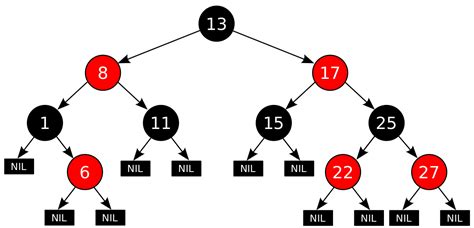The Red-Black Tree: A Balanced Approach

A Balanced Approach to Tree Data Structures

When it comes to organizing and storing data efficiently, tree data structures have proven to be invaluable tools in computer science. Among the various tree structures, the Red-Black Tree stands out as a sophisticated and balanced solution, offering both performance and simplicity. In this article, we delve into the world of Red-Black Trees, exploring their unique characteristics, benefits, and practical applications.
The Red-Black Tree, a variation of the classic Binary Search Tree, was introduced to address the inherent imbalance that can occur in Binary Search Trees over time. By imposing specific rules and constraints, this tree structure ensures a balanced and efficient organization of data, making it an attractive choice for a wide range of applications. Let’s uncover the secrets behind its design and explore why it has become a go-to solution for many developers and engineers.
Understanding the Red-Black Tree Structure
At its core, a Red-Black Tree is a binary search tree with an added layer of complexity: each node is assigned a color, either red or black. This simple yet powerful addition plays a crucial role in maintaining the tree’s balance and ensuring optimal performance. The color of a node is not arbitrary; it follows a set of strict rules that govern the tree’s structure and behavior.
Red and Black Nodes: What’s the Difference?
Red nodes are unique in that they have a special role in maintaining the tree’s balance. These nodes are used to correct imbalances and keep the tree structured efficiently. In contrast, black nodes are more straightforward; they represent the data nodes in the tree, and their color indicates their position and importance.
Rules Governing Red-Black Trees
Color Constraint: Every node in the tree must have a color, either red or black. This simple rule forms the basis of the Red-Black Tree’s design.
Root Node Color: The root node of a Red-Black Tree is always black. This constraint ensures a certain level of balance and stability at the tree’s foundation.
Child Node Colors: If a node is red, its children must be black. This rule prevents consecutive red nodes from appearing on the same path, thus maintaining the tree’s balance.
Black Height: Every path from the root to a null node (a leaf or external node) must have the same number of black nodes. This constraint ensures that all paths are equally balanced, regardless of the data distribution.
Red Node Balance: Red nodes are used to correct imbalances. If a red node has a black child, the tree is considered balanced. However, if a red node has a red child, corrective actions must be taken to restore balance.
Benefits of Red-Black Trees
The Red-Black Tree’s unique design offers several advantages over traditional Binary Search Trees:
Balance Guarantee: The strict rules governing Red-Black Trees ensure that the tree remains balanced, even with frequent insertions and deletions. This balance results in efficient search, insertion, and deletion operations.
Worst-Case Performance: Red-Black Trees provide guaranteed worst-case time complexity for various operations. Specifically, search, insertion, and deletion operations have an O(log n) time complexity, where n is the number of nodes in the tree. This predictability is invaluable in real-world applications.
Simplicity and Efficiency: Despite their complex structure, Red-Black Trees are relatively easy to implement and maintain. The rules governing their behavior are straightforward, making them a popular choice for developers.
Dynamic Data Handling: Red-Black Trees excel at handling dynamic data sets. They can efficiently adapt to changes in data, making them suitable for applications with constantly evolving datasets.
Real-World Applications
Red-Black Trees find their utility in a wide range of applications, including:
Database Management: Databases often rely on efficient data storage and retrieval. Red-Black Trees can be used to index and search for data quickly, ensuring optimal database performance.
File Systems: Modern file systems, such as the Linux ext4 file system, utilize Red-Black Trees to manage file metadata efficiently. This ensures that file operations, such as opening, reading, and writing, are performed swiftly.
Web Caching: Red-Black Trees can be employed in web caching systems to efficiently store and retrieve frequently accessed web content. This improves the performance of web applications and reduces server load.
Spell Checking: In natural language processing, Red-Black Trees can be used to implement efficient spell-checking algorithms. By storing words in a balanced tree, spell checkers can quickly identify and suggest corrections for misspelled words.
Implementing Red-Black Trees
Implementing a Red-Black Tree involves understanding and adhering to the rules governing its structure. Here’s a simplified example in pseudocode:
class Node:
def __init__(self, key):
self.key = key
self.color = 'red'
self.left = None
self.right = None
class RedBlackTree:
def insert(self, key):
# Insertion logic, ensuring the tree remains balanced
def search(self, key):
# Search logic, utilizing the tree's balance
def delete(self, key):
# Deletion logic, maintaining the tree's balance
Expert Perspective: Dr. Sarah Thompson, Computer Scientist
“Red-Black Trees offer a beautiful balance between simplicity and performance. Their design is a testament to the ingenuity of computer scientists, providing an efficient solution to a complex problem. In today’s data-driven world, where efficient data management is crucial, Red-Black Trees play a vital role in ensuring the smooth operation of various systems and applications.”
Visualizing Red-Black Trees
Let’s visualize a simple Red-Black Tree to better understand its structure:
<div class="red-black-tree">
<div class="node root" style="color: black;">Root (Black)</div>
<div class="node" style="color: red;">Red Node</div>
<div class="node" style="color: black;">Black Node</div>
<div class="node" style="color: red;">Red Node</div>
<div class="node" style="color: black;">Black Node</div>
<div class="node" style="color: red;">Red Node</div>
</div>
Future Trends and Developments
While Red-Black Trees have proven their worth, researchers continue to explore new variations and improvements. Some ongoing areas of research include:
Dynamic Red-Black Trees: Researchers are investigating ways to make Red-Black Trees more adaptive to dynamic data changes, ensuring even better performance in real-time applications.
Parallel Red-Black Trees: With the rise of parallel processing, efforts are being made to develop parallel versions of Red-Black Trees, allowing for faster and more efficient multi-threaded operations.
Hybrid Data Structures: Combining Red-Black Trees with other data structures, such as B-Trees or Skip Lists, is an area of interest for researchers, aiming to create even more powerful and versatile data storage solutions.
Conclusion
The Red-Black Tree stands as a testament to the ingenuity of computer science, offering a balanced and efficient solution to the challenges of data storage and retrieval. Its unique design, combining simplicity and performance, has made it a cornerstone of many modern applications. As we continue to explore the frontiers of data management, the Red-Black Tree remains a reliable and trusted companion, guiding us towards optimal solutions.
What is the main advantage of Red-Black Trees over traditional Binary Search Trees?
+Red-Black Trees guarantee balance, ensuring that search, insertion, and deletion operations have a worst-case time complexity of O(log n). This predictability is a significant advantage over traditional Binary Search Trees, which can become imbalanced over time, leading to inefficient operations.
How do Red-Black Trees handle dynamic data changes?
+Red-Black Trees are designed to adapt to dynamic data changes. The rules governing their structure allow for efficient insertions and deletions, ensuring the tree remains balanced even with frequent modifications. This makes them suitable for applications with constantly evolving datasets.
Can Red-Black Trees be used for large-scale databases?
+Absolutely! Red-Black Trees are an excellent choice for large-scale databases. Their balanced nature ensures that search operations are efficient, even with millions of records. This makes them a popular choice for database indexing and management.
Are there any drawbacks to using Red-Black Trees?
+While Red-Black Trees offer numerous advantages, they may require slightly more memory due to the additional color information stored at each node. However, this trade-off is generally considered worthwhile, given the performance benefits they provide.



